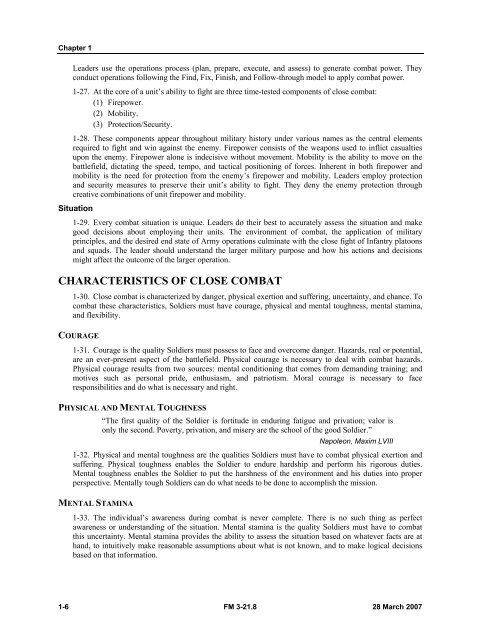Infantry Rifle Platoon and Squad - Sakai
Infantry Rifle Platoon and Squad - Sakai
Infantry Rifle Platoon and Squad - Sakai
You also want an ePaper? Increase the reach of your titles
YUMPU automatically turns print PDFs into web optimized ePapers that Google loves.
Chapter 1<br />
Leaders use the operations process (plan, prepare, execute, <strong>and</strong> assess) to generate combat power. They<br />
conduct operations following the Find, Fix, Finish, <strong>and</strong> Follow-through model to apply combat power.<br />
1-27. At the core of a unit’s ability to fight are three time-tested components of close combat:<br />
(1) Firepower.<br />
(2) Mobility.<br />
(3) Protection/Security.<br />
1-28. These components appear throughout military history under various names as the central elements<br />
required to fight <strong>and</strong> win against the enemy. Firepower consists of the weapons used to inflict casualties<br />
upon the enemy. Firepower alone is indecisive without movement. Mobility is the ability to move on the<br />
battlefield, dictating the speed, tempo, <strong>and</strong> tactical positioning of forces. Inherent in both firepower <strong>and</strong><br />
mobility is the need for protection from the enemy’s firepower <strong>and</strong> mobility. Leaders employ protection<br />
<strong>and</strong> security measures to preserve their unit’s ability to fight. They deny the enemy protection through<br />
creative combinations of unit firepower <strong>and</strong> mobility.<br />
Situation<br />
1-29. Every combat situation is unique. Leaders do their best to accurately assess the situation <strong>and</strong> make<br />
good decisions about employing their units. The environment of combat, the application of military<br />
principles, <strong>and</strong> the desired end state of Army operations culminate with the close fight of <strong>Infantry</strong> platoons<br />
<strong>and</strong> squads. The leader should underst<strong>and</strong> the larger military purpose <strong>and</strong> how his actions <strong>and</strong> decisions<br />
might affect the outcome of the larger operation.<br />
CHARACTERISTICS OF CLOSE COMBAT<br />
1-30. Close combat is characterized by danger, physical exertion <strong>and</strong> suffering, uncertainty, <strong>and</strong> chance. To<br />
combat these characteristics, Soldiers must have courage, physical <strong>and</strong> mental toughness, mental stamina,<br />
<strong>and</strong> flexibility.<br />
COURAGE<br />
1-31. Courage is the quality Soldiers must possess to face <strong>and</strong> overcome danger. Hazards, real or potential,<br />
are an ever-present aspect of the battlefield. Physical courage is necessary to deal with combat hazards.<br />
Physical courage results from two sources: mental conditioning that comes from dem<strong>and</strong>ing training; <strong>and</strong><br />
motives such as personal pride, enthusiasm, <strong>and</strong> patriotism. Moral courage is necessary to face<br />
responsibilities <strong>and</strong> do what is necessary <strong>and</strong> right.<br />
PHYSICAL AND MENTAL TOUGHNESS<br />
“The first quality of the Soldier is fortitude in enduring fatigue <strong>and</strong> privation; valor is<br />
only the second. Poverty, privation, <strong>and</strong> misery are the school of the good Soldier.”<br />
Napoleon, Maxim LVIII<br />
1-32. Physical <strong>and</strong> mental toughness are the qualities Soldiers must have to combat physical exertion <strong>and</strong><br />
suffering. Physical toughness enables the Soldier to endure hardship <strong>and</strong> perform his rigorous duties.<br />
Mental toughness enables the Soldier to put the harshness of the environment <strong>and</strong> his duties into proper<br />
perspective. Mentally tough Soldiers can do what needs to be done to accomplish the mission.<br />
MENTAL STAMINA<br />
1-33. The individual’s awareness during combat is never complete. There is no such thing as perfect<br />
awareness or underst<strong>and</strong>ing of the situation. Mental stamina is the quality Soldiers must have to combat<br />
this uncertainty. Mental stamina provides the ability to assess the situation based on whatever facts are at<br />
h<strong>and</strong>, to intuitively make reasonable assumptions about what is not known, <strong>and</strong> to make logical decisions<br />
based on that information.<br />
1-6 FM 3-21.8 28 March 2007

















